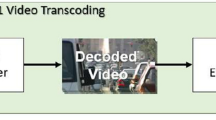Abstract
High-Efficiency Video Coding (HEVC) was conceived by the Joint Collaborative Team on Video Coding as the natural successor of the H.264/AVC standard, which has been the most extended digital video standard in all segments of the domestic and professional markets for over 10 years. HEVC roughly doubles the compression performance of H.264/AVC in Rate-Distortion terms at the expense of a high computational cost. Thus, most of the previous-generation devices can decode H.264/AVC streams but they cannot decode HEVC yet, while emerging devices are supposed to be able to decode both standards. Video providers should take advantage of bandwidth reduction using HEVC when possible, but they should also provide compatible streams to older devices, making it necessary to encode the same stream using both H.264/AVC and HEVC standards. This paper presents a coding tree unit splitting algorithm for a heterogeneous simultaneous encoding scenario which makes use of information from H.264/AVC encoder to make faster decisions in HEVC. Experimental results show that the proposed algorithm can achieve a good trade-off between coding efficiency and complexity.



Similar content being viewed by others
References
Adhikari VK, Guo Y, Hao F, Varvello M, Hilt V, Steiner M, Zhang ZL (2012) Unreeling netflix: understanding and improving multi-CDN movie delivery. In: INFOCOM’12. IEEE, pp 1620–1628
Bjontegaard G (2008) Improvements of the BD-PSNR model. ITU-T SG16 Q 6:35
Bossen F (2013) Common HM test conditions and software reference configurations. In: Proc. 12th JCT-VC meeting, Doc. JCTVC-L1100
Bossen F, Bross B, Suhring K, Flynn D (2012) HEVC complexity and implementation analysis. IEEE Trans Circuits Syst Video Technol 22(12):1685–1696
Chen J, Boyce J, Yan Y, Hannuksela M, Sullivan G, Wang Y (2014) Scalable high efficiency video coding draft 7. In: JCTVC-R1008, 18th JCTVC meeting, Sapporo
De Praeter J, Diaz-Honrubia A, Van Kets N, Van Wallendael G, De Cock J, Van de Walle R (2015) Fast simultaneous video encoder for adaptive streaming. In: Proc. IEEE int. workshop multimedia signal process (MMSP), pp 1–6
Diaz-Honrubia AJ, Martinez JL, Cuenca P, Gamez JA, Puerta JM (2015) A statistical approach of a CTU splitting algorithm for a H.264/ AVC to HEVC video transcoder. In: 15th international conference on computational and mathematical methods in science and engineering, Rota
Espeland H, Stensland HK, Finstad DH, Halvorsen P (2012) Reducing processing demands for multi-rate video encoding: implementation and evaluation. Int J Multimedia Data Eng Manag (IJMDEM) 3(2):1–19
Fayyad UM, Irani KB (1993) Multi-interval discretization of continuous-valued attributes for classification learning. In: Proceedings of the international joint conference on uncertainty in AI
Finstad D, Stensland H, Espeland H, Halvorsen P (2011) Improved multi-rate video encoding. In: Proc. IEEE int. symposium multimedia (ISM), pp 293–300
Guyon I, Elisseeff A (2003) An introduction to variable and feature selection. J Mach Learn Res 3:1157–1182
Han W, Min J, Kim I, Alshina E, Alshin A, Lee T, Chen J, Seregin V, Lee S, Hong Y, Cheon M, Shlyakhov N, McCann K, Davies T, Park J (2012) Improved video compression efficiency through flexible unit representation and corresponding extension of coding tools. IEEE Trans Circuits Syst Video Technol 20(12):1899–1909
HM reference software. https://hevc.hhi.fraunhofer.de/svn/svn_HEVCSoftware/. Accessed 1 Sept 2015
ITU-T Rec. H.264 and ISO/IEC 14496–10 (AVC) version 16: advanced video coding for generic audiovisual services (2012)
ITU-T Recommendation H.265 and ISO/IEC 23008-2 (Version 1): high efficiency video coding (2013)
Joint Collaborative Team on Video Coding: reference software to committee draft, version 18.4 (2012)
Ohm J, Sullivan G, Schwarz H, Tan TK, Wiegand T (2012) Comparison of the coding efficiency of video coding standards—including high efficiency video coding (HEVC). IEEE Trans Circuits Syst Video Technol 22(12):1669–1684
Peixoto E, Shanableh T, Izquierdo E (2014) H.264/AVC to HEVC video transcoder based on dynamic thresholding and content modeling. IEEE Trans Circuits Syst Video Technol 24(1):99–112
Schroeder D, Rehm P, Eckehard S (2015) Block structure reuse for multi-rate high efficiency video coding. In: Proc. IEEE int. conf. image process (ICIP), pp 3972–3976
Shen T, Lu Y, Wen Z, Zou L, Chen Y, Wen J (2013) Ultra fast H.264/AVC to HEVC transcoder. In: Data compression conference (DCC’13), Salt Lake City
Sullivan GJ, Ohm JR, Han WJ, Wiegand T (2012) Overview of the high efficiency video coding (HEVC) standard. IEEE Trans Circuits Syst Video Technol 22(12):1649–1668
Zaccarin A, Yeo BL (2002) Multi-rate encoding of a video sequence in the dct domain. In: Proc. IEEE int. symposium circuits syst. (ISCAS), vol 2, pp II-680–II-683
Author information
Authors and Affiliations
Corresponding author
Additional information
This work has been jointly supported by the MINECO and European Commission (FEDER funds) under the Projects TIN2012-38341-C04-04, TIN2013-46638-C3-3-P and TIN2015-66972-C5-2-R. This work has also been supported by the Spanish MECD under Grant FPU 12/00994. Finally, it is partly supported by the European Union FEDER (CAPAP-H5 network TIN2014-53522-REDT).
Rights and permissions
About this article
Cite this article
Diaz-Honrubia, A.J., De Praeter, J., Van Wallendael, G. et al. CTU splitting algorithm for H.264/AVC and HEVC simultaneous encoding. J Supercomput 73, 190–202 (2017). https://doi.org/10.1007/s11227-016-1683-1
Published:
Issue Date:
DOI: https://doi.org/10.1007/s11227-016-1683-1




